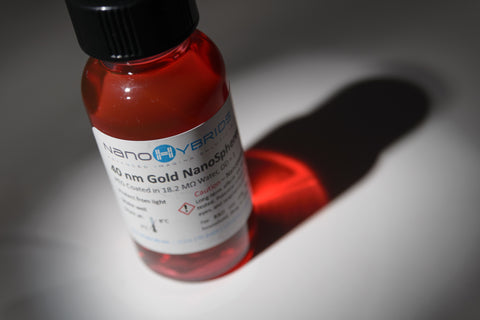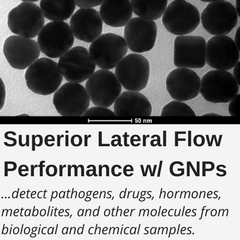Lateral Flow Assays (LFAs) are powerful and easy to use diagnostic tools. They most frequently rely on the power of gold nanoparticles (GNPs) to indicate the presence of target analytes or biomolecules. These tests are commonly found on the shelves of your neighborhood pharmacy, in addition to being used by top hospitals and researchers. Let’s take a look at how these simple, yet highly reliable nanoparticle tests work to give us valuable information about our health and more.
A Test by Any Other Name…
Lateral Flow Assays have many names including:
- Lateral Flow Tests
- Lateral Flow Immunochromatagraphic Assays
- Flow immunoassays
- Rapid Strip Tests
- Sandwich Assays
But whatever you chose to call a lateral flow assay the principals of their design and function are fairly standard.
Achieving Flow
As the name implies the fundamental nature of these tests relies on the passive flow of fluids through the test strip from one end to the other. Liquid flow is achieved with the capillary action of porous membranes, most commonly made of paper materails.
Imagine a spilled drink. Putting a paper towel on the spill it quickly absorbs the fluid without any external force. The liquid’s movement through the paper towel towards the dry absorbent ends is easily noted. The same wicking capillary action is at work in lateral flow assays.
4 Principal Parts of LFA Test Strips
- The capillary force driving the liquid flows across the device is maintained by an absorbent pad attached the back end of the end of the strip. The absorbent pad wicks excess reagents and prevents liquid backflow.
- On the front end of the test strip is the sample pad. As its name implies, this is where the sample fluid to be tested is applied, and it ensures the target analyte is absorbed through the test strip.
- Once the sample has been applied to the test strip the target analyte in the liquid matrix is wicked into the conjugate release pad. This pad contains antibodies specific to the target analyte which have been conjugated to detection labels. When the sample enters the conjugation release pad the conjugated antibody binds to the target analyte. The sample with bound antibody and conjugated label are then carried to the final detection zone of the test strip where the results are produced.
- The detection zone is comprised of the reaction pad, which is commonly made of nitrocellulose. The reaction pad is created with immobilized lines of antibodies or antigens which cannot be carried away in the flow. The simplest systems contain two lines, a test line and a control line.

Reaction Lines on a LFA
The test line contains antibodies for the target molecule, and binds the analyte which is already attached to the conjugated antibody acquired in the conjugate release pad. Essentially, the target analyte is sandwiched between two antibodies; one immobilized on the test line and the second conjugated to the detection label. This often leads to LFAs being referred to as “Sandwich Assays”.
The control line is used to verify that the test was functional and valid. Excess conjugated antibodies from the conjugate release pad that did not attach to the target analyte are still carried down the test strip with the sample liquid flow. Because these excess conjugated antibodies are not attached to the analyte they are not sequestered at the test line. However, they can bind specific antigens or secondary antibodies immobilized at the control line. This ensures that the porous membrane was not blocked and that there was proper sample flow through the test strip.
GNPs Serve an Important Diagnostic Role
According to a published article in Essays in Biochemistry1:
“The most important requirements of the nanoparticle label include:
- colloidal stability in solution under various conditions and temperatures
- susceptibility for detection over a large (and useful) dynamic range
- efficiency & reproducibility of conjugation (w/o loss of chemical and biological integrity & activity)
- lack of or very low non-specific binding characteristics (ensuring a high signal-to-noise ratio)
- commercial availability at low cost
- easy and scalable conjugation procedure”
Because of such requirements, gold nanoparticles are an excellent label for lateral flow assays and the most commonly used. They are cost effective, and maintain exceptional stability against degradation for extended periods of time. Further, gold nanospheres have high affinity for biomolecules to quickly and easily conjugate antibodies. Finally, their unique optical properties arising from surface plasmon reference (SPR) produce a reliable red indication that is clearly visable to the naked eye without the need for additional development.

40 nm Gold NanoSpheres are the most popular choice for lateral flow assays because of an the combination of a high contrast cherry red color (absorption ~523 nm) and optimal surface area that minimizes conjugated antibody waste. With these properties, we can see how important quality gold nanoparticles labels are for powering lateral flow assays.
Test Read Out
When conjugated antibodies accumulate at the immobilized test and control lines the appearance of visible lines provides for easy assessment of test results. In the case of gold nanosphere labels, the most widely used labels, the visible lines are red in appearance and require no development process. This is due to the unique optical properties of colloidal gold known as surface plasmon resonance. The shade of red is determined by the size of the gold nanoparticle and intensity is a factor of the amount of conjugated antibody bound at the immobilized lines.
The formation of a red line at the test line indicates a positive result (i.e. the presence of the target analyte), and the intensity will depend on the amount of target analyte in the sample. For the control line, as long as the test was valid it should produce a clearly defined red indication.
LFAs in Daily Life
Lateral Flow Assays have a number of important application including environmental contamination assessment and point of care diagnostics. Probably the most well known home testing application is the pregnancy tests. Using the home pregnancy test, let’s examine a real-life example of the use of sandwich lateral flow assays.
When a woman become pregnant she almost immediately begins to produce human chorionic gonadotropin (hCG) hormone. At the earliest stages of pregancy, hCG signals the body not to shed the inner lining of the uterus. hCG has multiple antigenic sites, meaning that antibodies can bind to the hormone at more than one location. This makes it ideal for a direct or sandwich assay as described above.
In the example of the home pregnancy test, the sample matrix is urine through which hCG is excreted. Once applied to the sample pad the fluid will begin to flow through the test strip. Any hCG in the urine will bind to antibodies in the conjugate release pad. These antibodies are conjugated to gold nanospheres commonly. From there the sample flows to the reaction pad where the hCG will bind the immobilized antibodies at the test line via another antigenic site not already occupied by the GNP conjugated antibody. As more and more hCG molecule are sandwiched at the test line a red stripe will appear indicating a positive result for pregnancy. The unbound conjugated antibody will also flow to the reaction pad and produce a red line at the control to validate the test while excess fluid will be wicked into the absorbing pad.
Normal LFAs from pregnancy tests have hCG detection limit of approximately 20 to 100 mIU/ml. In all, they are a reliable, easy to use test that requires no additional equipment or training to interpret. Thanks to the design and properties of gold nanoparticles, and other labels, lateral flow assays have become a useful tool in many point of care diagnostic applications and serve an important role in healthcare and daily life.
Explore More:


References:
- Koczula, Katarzyna M., and Andrea Gallotta. “Lateral flow assays.” Essays in biochemistry 60.1 (2016): 111-120. doi: 10.1042/EBC20150012